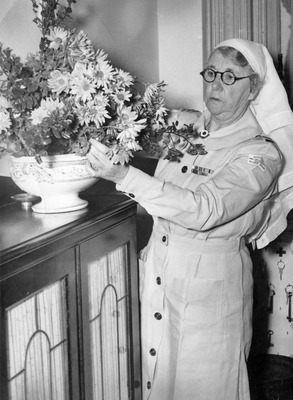A century on from the end of World War I we acknowledge their service …
Lest we forget.
Sister Nora Ellen Rhoden
Born: 6 November 1878 Sale. Died: 22 July 1952 Heidelberg.
Enlisted: 10 April 1915 aged 35
Served: Egypt, Western Front and England
Sister Nora is the only woman listed on any of Pakenham’s WWI memorials. She was born in Sale in 1878, the daughter of John Rhoden and Catherine (Kate) Connor. Her maternal grandfather, David Connor, was one of Pakenham’s earliest pioneers. For many years the Connors ran the Half Way Hotel, a Cobb and Co Coach Inn on the north side of the Princes Highway near what is now Abrehart Road. Part of the original building is preserved at Old Gippstown in Moe.
Nora first went to school at St Joseph’s in Warragul, where her mother ran the Railway Hotel. After Nora’s father died in 1886, her mother remarried, becoming Mrs Staveley. The family returned to Pakenham, where Kate was licensee of the family’s hotel during the 1890s.
Nora would have finished her education at St Patrick’s School during this time. While in Pakenham, she was active in local tennis, as well as fundraising for St Patrick’s Church. After her mother died in 1905, Nora trained as a nurse at the Alfred Hospital in Melbourne from 1907 to 1910. Her subsequent experience included a year and a half as night superintendent at the Alfred Hospital, six months as matron for a private city hospital and seven months working with a skin specialist in Melbourne.
Nora, who was described as “one of the best known members of the Australian Army Nursing Service”, enlisted as an army nurse in April 1915. She was appointed as a “staff nurse” and embarked for Egypt almost immediately. Interestingly, the AANS required its nurses to purchase many necessary items themselves, including: surgical scissors, clinical thermometers, forceps and a mackintosh (raincoat). They were also required to purchase a camp kit, including camp bed and mattress, a paraffin stove, kettle and other items. The total cost of these items was over £16, a not inconsiderable sum in those days. They also had to buy their own uniform. In effect, nurses like Nora had to pay for the privilege of serving their country!
Nora subsequently served in a hospital at Ismailia, then the 4th Auxiliary Hospital in Abbassia. In August 1916, she was sent to England before proceeding to France. After a period at the 29th Casualty Clearing Station, Nora was attached to the 1st Australian General Hospital (1AGH) at Rouen from late November 1916. This was one of the main Australian hospitals in France and was established on the Rouen Racecourse. A large proportion of the casualties on the Somme passed through this hospital.
The nursing was also physically demanding: Nora (who had been promoted to the rank of Sister in April 1917) was herself hospitalised in late December 1917 suffering from myalgia, which is often caused by overuse of the muscles. After recovering, Nora was attached to the 2nd Australian Auxiliary Hospital in London, where she served for the rest of the War. In early 1919, Nora was again suffering from myalgia and was invalided back to Australia, disembarking at Melbourne on 31 March 1919.
After the War, Nora continued her career with the AANS in Melbourne. This included serving at Caulfield Military Hospital, the Anzac Hostel for incapacitated soldiers and as matron of Stonnington Convalescent Home during WWII. In 1937, she was awarded the Coronation Medal, which commemorated the coronation of King George VI. Amongst other Victorians awarded the medal were General Sir Harry Chauvel; Major General Sir Thomas Blamey; future Prime Minister Robert Menzies and his wife Pattie; Justice Sir John Latham of the High Court; and Federal Treasurer (and Berwick identity) Richard Casey and his wife Maie.
Like many nurses of her generation, Nora never married. She died in July 1952 and was buried in Pakenham Cemetery.
This is an extract from Patrick Ferry’s book A Century After The Guns Fell Silent – Remembering the Pakenham District’s WWI Diggers 1914-18.
For more details on this and other profiles in the book, head to the website www.pakenhamww1.com







